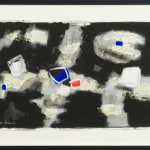



Jun Dobashi
Further images
DOBASHI Jun was born in Tokyo in 1910. He lived in Paris for 20 years since 1953, where he focused on painting. During that period in Paris, he immersed himself in the cruel yet liberating world of art without the help of anyone else. This experience was significantly unique from those of many Japanese artists who remained in Japan, where they maintained a traditional master-student relationship or where the regimental environment remained stifling for them.
His works were abstract, yet intense and emotionally expressive. He separated the abstract from the emotionally expressive aspects, resulting in a not-so-sweet effect. Despite his outpouring of emotions into the painting, it is clear that the he did not indulge too much into them. What can be considered as a “cold emotional expression” is the best part of Dobashi’s abstract art. He was a key figure among Japanese abstract artists in Japan during the 1950s and 1960s. He unfortunately passed away due to acute heart failure in 1978.
Join our mailing list
* denotes required fields
We will process the personal data you have supplied in accordance with our privacy policy (available on request). You can unsubscribe or change your preferences at any time by clicking the link in our emails.



